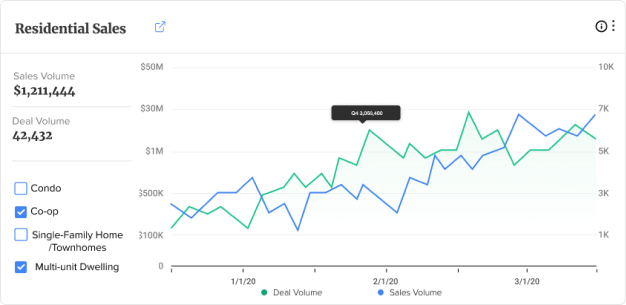The National Association of Realtors took big swings, and some costly misses, in spending nearly $400,000 on 23 candidates running for local offices in suburban and rural parts of Illinois this election season.
The country’s largest trade organization, which also runs one of the nation’s biggest political action committees, made expenditures in the form of mailers and digital advertisements supporting 14 Illinois candidates who won their local municipal races and nine who lost, a success rate of about 61 percent.
A political action committee funded by NAR invested in local mayoral, village trustee and city/town council races primarily in the Chicago suburbs and surrounding collar counties like Lake and McHenry counties. But the committee, Illinois Realtors Fund, also spent tens of thousands of dollars on candidates in rural areas like Madison County, near St. Louis.
NAR makes regular, lump-sum contributions to the Illinois Realtors Fund to support candidates based on proposals submitted by Illinois Realtors, its local affiliate. In advance of the April 1 election, NAR gave just under $223,700 to the Illinois Realtors Fund, adding to the fund’s balance of over $215,000, records show.
Create an account to continue

The group’s cheapest victory came in its support for the reelection campaign of Mike Adrieansen, mayor of Manhattan, a small town near Joliet with just under 9,400 residents, reports filed with the Illinois State Board of Elections show. It spent about $2,655 this year to help secure a second term for Adrieansen, who told Patch that he is pro-business and pro-development but opposes the nearby NorthPoint Development, a controversial plan backed by the city of Joliet to use more than 3,000 acres of land for industrial warehousing.
Illinois Realtors members vetted candidates based on critical housing and real estate issues including private property rights, housing stability and affordability, said Jeff Baker, president and CEO of the local NAR affiliate.
This election cycle also brought some pricey losses for the national trade organization, whose revenue is derived almost entirely from dues paid by its more than 1.5 million members.
NAR spent big supporting three candidates, who accounted for more than $117,870 and 30 percent of its donations to Illinois candidates this year.
One candidate, Dan Brady, won a three-way race to unseat the incumbent and become the next mayor of Bloomington, home of Illinois State University, after receiving $41,782 in spending by NAR. City elections are nonpartisan, but Brady served as a Republican state representative for 22 years and was criticized by his opponent for being a “MAGA Republican,” WTTW reported. He beat Mboka Mwilambwe, the first person of color to be elected mayor in Bloomington, and local alderman Cody Hendricks.
The other two candidates — Arlington Heights village trustee candidate Colin Gilbert and Gurnee mayoral candidate Quin O’Brien — lost their races, resulting in a more than $76,000 loss for NAR.
O’Brien, a real estate broker and founder of an internet-based real estate company called 4 Sale Realty Advantage, was the top-funded Illinois candidate with $44,325 in spending. But he garnered just 30 percent of the vote in his race, according to unofficial election results.
Just half of the 10 candidates that NAR spent $17,000 or more on won their races.
In general, NAR spent the most on mayoral races and races in more populous suburbs like Arlington Heights, Evanston and Joliet.
Suburban vs. Rural Spending
NAR’s political action committee took an interest in three races for Evanston City Council, the only Illinois municipality where it donated to multiple candidates. It spent $17,234 and $19,360 on incumbents Clare Kelly and Tom Suffredin, respectively, and another $19,153 on newcomer Parielle Davis, who ran for an open seat.
All three won their races, but Kelly’s race was a close call. She cleared her opponent, Stephen Hackney, by less than 40 votes.
The mailers and digital ads NAR bought to help propel the three candidates to victory accounted for 14 percent of the committee’s spending on Illinois candidates this election cycle.
Political action committees, like the Illinois Realtors Fund, that make independent expenditures, like mailers or commercials supporting a candidate, are not allowed to coordinate those activities with candidates, according to state law. Mailers contain small print letting voters know they are “not authorized by the candidate.”
The NAR-backed political fund made some more high-dollar expenditures in a few races outside Cook County. It weighed in on contests for Avon Township, which includes Round Lake and Grayslake in Lake County, and Madison County near St. Louis.
NAR spent nearly $18,000 to support real estate agent and NAR member Madelyn Staack in her race for one of four open spots for Avon Township Trustee in a field of eight candidates. Staack came in last, but the race was close with less than 350 votes separating her from the top vote-getter.
The political action committee saw a return on its more than $41,500 investment in three mayoral races within Avon Township: Grayslake, Round Lake and Round Lake Park.
In Round Lake, NAR spent about $13,400 on newcomer Brian Brubaker, who owns a real estate investment brokerage called Brubaker Group. Brubaker swept the race with over 79 percent of the vote, unseating the incumbent mayor.
Brubaker attributed the landslide victory to local frustration over two plots of land owned by a private developer that he said had been poorly managed, the Chicago Tribune reported. He said he plans to court new developers to make better use of the properties, one of which is being used as a recycling center.
NAR spent more than $22,000 on incoming Grayslake Mayor Elizabeth Davies, another newcomer who listed reducing the village’s property tax burden among her priorities.
The group spent just over $6,100 on incoming Round Lake Park Mayor Robert Seminary. Seminary and Davies won by landslides, with Davies garnering more than 90 percent of the vote.
It is unclear why NAR chose to spend so much on races in this part of Lake County, but the recent election comes at a time when the Grayslake area has drawn the attention of big tech developers looking to buy up land for data centers. The area is ideal for these purposes because of its access to fresh water needed to cool down computing equipment.
In January, Atlanta-based tech infrastructure developer T5 Data Centers paid $17 million to buy nearly 89 acres in Grayslake. The deal follows its $29 million purchase last year of a nearby plot of more than 134 acres from Wilmette-based real estate firm Alter Group.
The January acquisition will bolster T5’s plan to develop a massive data center campus with a capacity of 480 megawatts, starting with an initial building of a 60-megawatt capacity expected to be complete by 2027.
Environmentalists and residents in other Illinois communities with incoming data centers have expressed concern over their environmental impact, including water use and energy requirements. Incoming Grayslake Mayor Davies listed “investing in our environment” as one of four priorities outlined on her campaign website, stating that “work in this area is never done, and I will persist on this path.”
Read more


